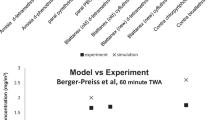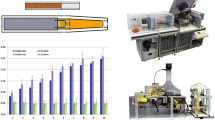Abstract
Inhalative exposure can occur accidentally when using cosmetic spray products. Usually, a tiered approach is applied for exposure assessment, starting with rather conservative, simplistic calculation models that may be improved with measured data and more refined modelling. Here we report on an advanced methodology to mimic in-use conditions for antiperspirant spray products to provide a more accurate estimate of the amount of aluminium possibly inhaled and taken up systemically, thus contributing to the overall body burden. Four typical products were sprayed onto a skin surrogate in defined rooms. For aluminium, size-related aerosol release fractions, i.e. inhalable, thoracic and respirable, were determined by a mass balance method taking droplet maturation into account. These data were included into a simple two-box exposure model, allowing calculation of the inhaled aluminium dose over 12 min. Systemic exposure doses were calculated for exposure of the deep lung and the upper respiratory tract using the Multiple Path Particle Deposition Model (MPPD) model. The total systemically available dose of aluminium was in all cases found to be less than 0.5 µg per application. With this study it could be demonstrated that refinement of the input data of the two-box exposure model with measured data of released airborne aluminium is a valuable approach to analyse the contribution of antiperspirant spray inhalation to total aluminium exposure as part of the overall risk assessment. We suggest the methodology which can also be applied to other exposure modelling approaches for spray products, and further is adapted to other similar use scenarios.






Similar content being viewed by others
References
Anjilvel S, Asgharian B (1995) A multiple-path model of particle deposition in the rat lung. Fundam Appl Toxicol 28:41–50
Bremmer HJ, Prud’Homme de Lodder LCH, van Engelen JGM (2006) Cosmetics fact sheet. To assess the risk for the consumer. Updated version for ConsExpo 4. RIVM report 320104001/2006
Carthew P, Griffiths H, Keech S, Hartop P (2002) Safety assessment for hair-spray resins: risk assessment based on rodent inhalation studies. Inhal Toxicol 14:401–416. https://doi.org/10.1080/08958370252871023
CEN (1993) European Committee for Standardization (CEN): Workplace atmospheres-size fraction definitions for measurement of airborne particles. CEN, British Standards Institute, London
Cheng KC, Acevedo-Bolton V, Jiang RT, Klepeis NE, Ott WR, Fringer OB, Hildemann LM (2011) Modeling exposure close to air pollution sources in naturally ventilated residences: association of turbulent diffusion coefficient with air change rate. Environ Sci Technol 45:4016–4022. https://doi.org/10.1021/es103080p
Comiskey D et al (2015) Novel database for exposure to fragrance ingredients in cosmetics and personal care products. Regul Toxicol Pharmacol 72:660–672. https://doi.org/10.1016/j.yrtph.2015.05.012
DeVoto E, Yokel RA (1994) The biological speciation and toxicokinetics of aluminium. Environ Health Perspect 102:940–951
ECHA (2016) Guidance on information requirements and chemical safety assessment; Chapter R.15: Consumer exposure assessment
Edwards CJC, Mills AK (1999) A Guide to Understanding Antiperspirant Formulations. In: Laden K (ed) Antiperspirants and Deodorants, 2nd edn. Marcel Dekker, New York
EFSA (2008) Scientific opinion of the panel on food additives, flavourings, processing aids and food contact materials (AFC). Safety of aluminium from dietary intake. EFSA J 6(7):754:1–34
FEA (2009) Guide on particle size measurement from aerosol products
FEA (2013) Guide on inhalation safety assessment for spray products
Finley B, Proctor D, Scott P, Harrington N, Paustenbach D, Price P (1994) Recommended distributions for exposure factors frequently used in health risk assessment. Risk Anal 14:533–553
Koch W, Dunkhorst W, Lödding H (1999) Design and performance of a new personal aerosol monitor. Aerosol Sci Technol 31:231–246. https://doi.org/10.1080/027868299304282
Koch W, Behnke W, Berger-Preiß E, Kock H, Gerling S, Hahn S, Schröder K (2012) Validation of an EDP assisted model for assessing inhalation exposure and dermal exposure during spraying processes, 1st edn. Bundesanstalt für Arbeitsschutz und Arbeitsmedizin (BAuA), Dortmund
Meek ME, Boobis AR, Crofton KM, Heinemeyer G, Raaij MV, Vickers C (2011) Risk assessment of combined exposure to multiple chemicals: a WHO/IPCS framework. Regul Toxicol Pharmacol 60:S1-S14. https://doi.org/10.1016/j.yrtph.2011.03.010
RIVM (2002) Multiple path particle dosimetry model (MPPD v 1.0): a model for human and rat airway particle dosimetry. RIVM, Bilthoven
Rothe H, Fautz R, Gerber E, Neumann L, Rettinger K, Schuh W, Gronewold C (2011) Special aspects of cosmetic spray safety evaluations: principles on inhalation risk assessment. Toxicol Lett 205:97–104. https://doi.org/10.1016/j.toxlet.2011.05.1038
Safford B et al (2015) Use of an aggregate exposure model to estimate consumer exposure to fragrance ingredients in personal care and cosmetic products. Regul Toxicol Pharmacol 72:673–682. https://doi.org/10.1016/j.yrtph.2015.05.017
Salem H, Katz SA (2006) Inhalation toxicology, 2nd edn. CRC Taylor & Francis, BocaRaton
Schwarz K, Koch W (2017) Thoracic and respirable aerosol fractions of spray products containing non-volatile compounds. J Occup Environ Hyg 14:831–838. https://doi.org/10.1080/15459624.2017.1335403
Steiling W, Buttgereit P, Hall B, O’Keeffe L, Safford B, Tozer S, Coroama M (2012) Skin exposure to deodorants/antiperspirants in aerosol form. Food Chem Toxicol 50:2206–2215. https://doi.org/10.1016/j.fct.2012.03.058
Steiling W et al (2014) Principle considerations for the risk assessment of sprayed consumer products. Toxicol Lett 227:41–49. https://doi.org/10.1016/j.toxlet.2014.03.005
Zaripov S, Koch W (2014) Numerical Study of the RespiCon Sampler Performance in the Calm Air. Aerosol Sci Technol 48:74–80. https://doi.org/10.1080/02786826.2013.859653
Acknowledgements
We would like to thank Dr. Clare Vickers and Dr. Helge Weingart for proofreading the manuscript. All authors read and approved the final manuscript.
Author information
Authors and Affiliations
Corresponding author
Ethics declarations
Conflict of interest
The authors G. Pappa, H. Miertsch and J. Scheel are employees of the sponsor of the studies. However, this did not influence the objectivity of the performed study. The authors declare that they have no conflict of interest.
Rights and permissions
About this article
Cite this article
Schwarz, K., Pappa, G., Miertsch, H. et al. A methodology for the assessment of inhalation exposure to aluminium from antiperspirant sprays. Arch Toxicol 92, 1383–1392 (2018). https://doi.org/10.1007/s00204-017-2151-2
Received:
Accepted:
Published:
Issue Date:
DOI: https://doi.org/10.1007/s00204-017-2151-2




